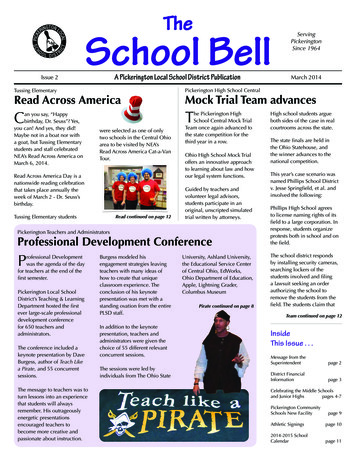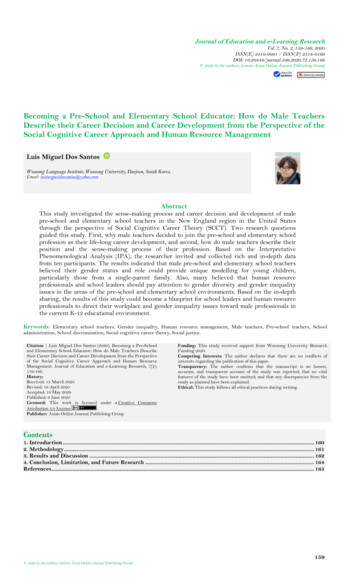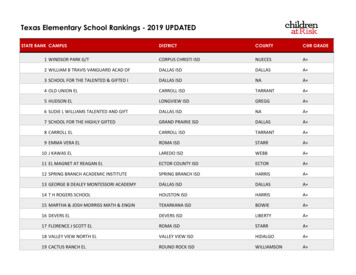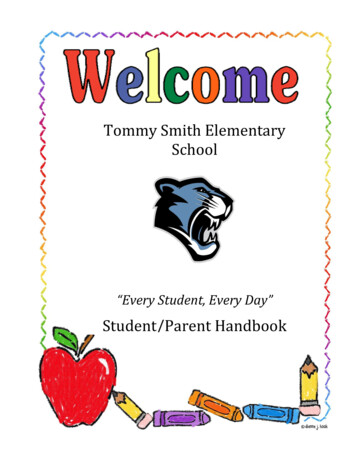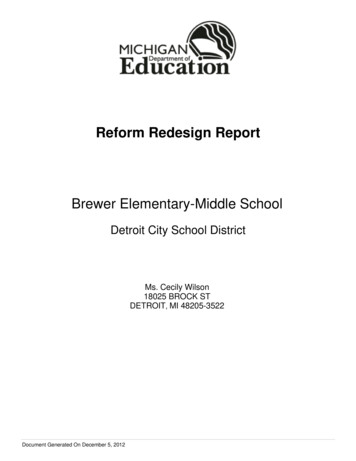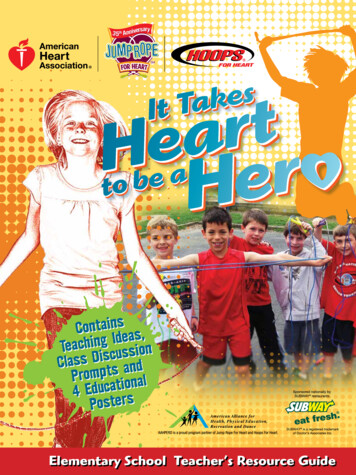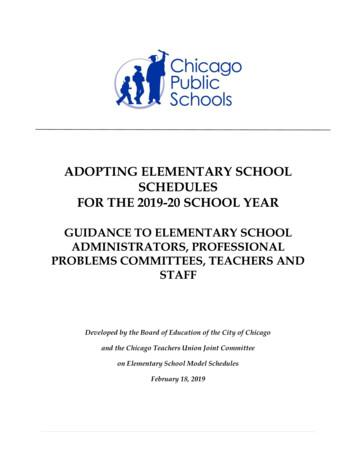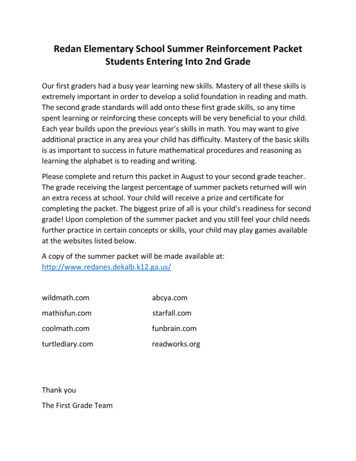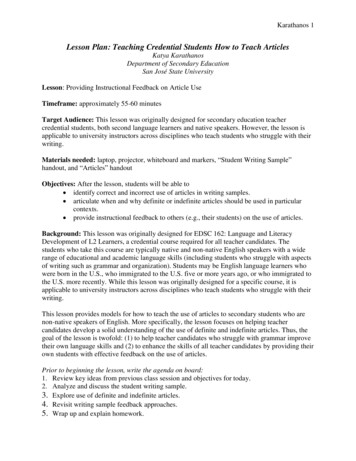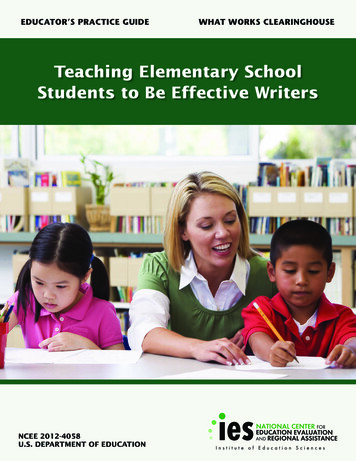
Transcription
EDUCATOR’S PRACTICE GUIDEWHAT WORKS CLEARINGHOUSETeaching Elementary SchoolStudents to Be Effective WritersNCEE 2012-4058U.S. DEPARTMENT OF EDUCATION
The Institute of Education Sciences (IES) publishes practice guides in education to bring the bestavailable evidence and expertise to bear on current challenges in education. Authors of practiceguides combine their expertise with the findings of rigorous research, when available, to developspecific recommendations for addressing these challenges. The authors rate the strength of theresearch evidence supporting each of their recommendations. See Appendix A for a full descriptionof practice guides.The goal of this practice guide is to offer educators specific, evidence-based recommendationsthat address the challenge of teaching writing in elementary school. The guide provides practical,clear information on critical topics related to teaching writing and is based on the best availableevidence as judged by the authors.Practice guides published by IES are available on our website by selecting the “Practice Guides”tab at http://ies.ed.gov/ncee/wwc/publications reviews.aspx#pubsearch.
IES Practice GuideTeaching Elementary School Studentsto Be Effective WritersJune 2012PanelSteve Graham (Chair)Arizona State UniversityAlisha BollingerNorris Elementary School, Norris School District, NebraskaCarol Booth OlsonUniversity of California, IrvineCatherine D’AoustUniversity of California, IrvineCharles MacArthurUniversity of DelawareDeborah McCutchenUniversity of WashingtonNatalie OlinghouseUniversity of ConnecticutStaffM. C. BradleyVirginia KnechtelBryce OnaranCassandra Pickens JewellMathematica Policy ResearchProject OfficerJoy LesnickInstitute of Education SciencesNCEE 2012-4058U.S. DEPARTMENT OF EDUCATION
This report was prepared for the National Center for Education Evaluation and Regional Assistance,Institute of Education Sciences under Contract ED-07-CO-0062 by the What Works Clearinghouse,which is operated by Mathematica Policy Research.DisclaimerThe opinions and positions expressed in this practice guide are those of the authors and do notnecessarily represent the opinions and positions of the Institute of Education Sciences or theU.S. Department of Education. This practice guide should be reviewed and applied according tothe specific needs of the educators and education agency using it, and with full realization thatit represents the judgments of the review panel regarding what constitutes sensible practice,based on the research that was available at the time of publication. This practice guide should beused as a tool to assist in decisionmaking rather than as a “cookbook.” Any references within thedocument to specific education products are illustrative and do not imply endorsement of theseproducts to the exclusion of other products that are not referenced.U.S. Department of EducationArne DuncanSecretaryInstitute of Education SciencesJohn Q. EastonDirectorNational Center for Education Evaluation and Regional AssistanceRebecca A. MaynardCommissionerJune 2012This report is in the public domain. Although permission to reprint this publication is not necessary,the citation should be:Graham, S., Bollinger, A., Booth Olson, C., D’Aoust, C., MacArthur, C., McCutchen, D., & Olinghouse,N. (2012). Teaching elementary school students to be effective writers: A practice guide (NCEE 20124058). Washington, DC: National Center for Education Evaluation and Regional Assistance, Institute of Education Sciences, U.S. Department of Education. Retrieved from http://ies.ed.gov/ncee/wwc/publications reviews.aspx#pubsearch.What Works Clearinghouse practice guide citations begin with the panel chair, followed by thenames of the panelists listed in alphabetical order.This report is available on the IES website at http://ies.ed.gov/ncee and http://ies.ed.gov/ncee/wwc/publications reviews.aspx#pubsearch.Alternate FormatsOn request, this publication can be made available in alternate formats, such as Braille, large print, orCD. For more information, contact the Alternate Format Center at (202) 260–0852 or (202) 260–0818.
ContentsTeaching Elementary School Studentsto Be Effective WritersTable of ContentsReview of Recommendations . . . . . . . . . . . . . . . . . . . . . . . . . . 1Acknowledgements . . . . . . . . . . . . . . . . . . . . . . . . . . . . . . 2Institute of Education Sciences Levels of Evidence for Practice Guides . . . . . . . . 3Introduction to the Teaching Elementary School Studentsto Be Effective Writers Practice Guide . . . . . . . . . . . . . . . . . . . . 6Recommendation 1. Provide daily time for students to write . . . . . . . . . . . . . 10Recommendation 2. Teach students to use the writing process for a variety of purposes . . . . 12Understanding the Writing Process. . . . . . . . . . . . . . . . . . . . . . . . . 14Recommendation 2a. Teach students the writing process . . . . . . . . . . . . 15Recommendation 2b. Teach students to write for a variety of purposes . . . . . . 20Recommendation 3. Teach students to become fluent with handwriting, spelling,sentence construction, typing, and word processing. . . . . . . . . . . . . . . . . . 27Recommendation 4. Create an engaged community of writers . . . . . . . . . . . . 34Glossary. . . . . . . . . . . . . . . . . . . . . . . . . . . . . . . . . . . 40Appendix A. Postscript from the Institute of Education Sciences. . . . . . . . . . . . 43Appendix B. About the Authors . . . . . . . . . . . . . . . . . . . . . . . . . 45Appendix C. Disclosure of Potential Conflicts of Interest. . . . . . . . . . . . . . . . 47Appendix D. Rationale for Evidence Ratings . . . . . . . . . . . . . . . . . . . . 48Endnotes . . . . . . . . . . . . . . . . . . . . . . . . . . . . . . . . . . 81References. . . . . . . . . . . . . . . . . . . . . . . . . . . . . . . . . . 99( iii )
Table of Contents (continued)List of TablesTable 1. Institute of Education Sciences levels of evidence for practice guides . . . . . . . . 4Table 2. Recommendations and corresponding levels of evidence . . . . . . . . . . . .9Table 3. Examples of writing strategies. . . . . . . . . . . . . . . . . . . . . . . 16Table 4. Purposes for writing . . . . . . . . . . . . . . . . . . . . . . . . . . 21Table 5. Examples of techniques within the four purposes of writing . . . . . . . . . . . 26Table 6. Spelling skills by grade level . . . . . . . . . . . . . . . . . . . . . . . 29Table 7. Activities for sentence-structure development. . . . . . . . . . . . . . . . . 31Table D.1. Studies that contribute to the level of evidence for Recommendation 1 . . . . . . 51Table D.2. Supplemental evidence supporting the effectiveness of Recommendation 1. . . . 52Table D.3. Studies that contribute to the level of evidence for Recommendation 2. . . . . . 54Table D.4. Supplemental evidence supporting the effectiveness of Recommendation 2. . . . 64Table D.5. Studies that contribute to the level of evidence for Recommendation 3. . . . . . 73Table D.6. Supplemental evidence supporting the effectiveness of Recommendation 3. . . . 74Table D.7. Studies that contribute to the level of evidence for Recommendation 4 . . . . . . 78Table D.8. Supplemental evidence supporting the effectiveness of Recommendation 4. . . . 79List of FiguresFigure 1. Gradual release of responsibility to students. . . . . . . . . . . . . . . . . 18Figure 2. Handwriting-practice diagram . . . . . . . . . . . . . . . . . . . . . . 28List of ExamplesExample 1. Applying the writing process in an upper elementary classroom . . . . . . . . 20Example 2. Story emulation of Rosie’s Walk with 1st-grade students . . . . . . . . . . . 23Example 3. Using text as a model . . . . . . . . . . . . . . . . . . . . . . . . 24Example 4. The Westward Movement prompt . . . . . . . . . . . . . . . . . . . 36Example 5. “Star of the Day” . . . . . . . . . . . . . . . . . . . . . . . . . . 37Example 6. “Author’s Chair”. . . . . . . . . . . . . . . . . . . . . . . . . . 38( iv )
Review of RecommendationsRecommendation 1.Provide daily time for students to write.Recommendation 2.Teach students to use the writing process for a variety of purposes.Recommendation 2a.Teach students the writing process.1. Teach students strategies for the various components of the writing process.2. Gradually release writing responsibility from the teacher to the student.3. Guide students to select and use appropriate writing strategies.4. Encourage students to be flexible in their use of the components of the writing process.Recommendation 2b.Teach students to write for a variety of purposes.1. Help students understand the different purposes of writing.2. Expand students’ concept of audience.3. Teach students to emulate the features of good writing.4. Teach students techniques for writing effectively for different purposes.Recommendation 3.Teach students to become fluent with handwriting, spelling, sentence construction, typing, andword processing.1. Teach very young writers how to hold a pencil correctly and form letters fluently and efficiently.2. Teach students to spell words correctly.3. Teach students to construct sentences for fluency, meaning, and style.4. Teach students to type fluently and to use a word processor to compose.Recommendation 4.Create an engaged community of writers.1. Teachers should participate as members of the community by writing and sharing their writing.2. Give students writing choices.3. Encourage students to collaborate as writers.4. Provide students with opportunities to give and receive feedback throughout the writing process.5. Publish students’ writing, and extend the community beyond the classroom.(1)
AcknowledgmentsThe panel appreciates the efforts of Virginia Knechtel, M. C. “Cay” Bradley, Bryce Onaran, andCassie Pickens Jewell, staff from Mathematica Policy Research who participated in the panelmeetings, described the research findings, and drafted the guide. We also thank Scott Cody, KristinHallgren, David Hill, Claudia Gentile, Brian Gill, and Shannon Monahan for helpful feedback andreviews of drafts of the guide.Steve GrahamAlisha BollingerCarol Booth OlsonCatherine D’AoustCharles MacArthurDeborah McCutchenNatalie Olinghouse(2)
Levels of Evidence for Practice GuidesInstitute of Education Sciences Levels of Evidence for Practice GuidesThis section provides information about the role of evidence in Institute of Education Sciences’(IES) What Works Clearinghouse (WWC) practice guides. It describes how practice guide panelsdetermine the level of evidence for each recommendation and explains the criteria for each of thethree levels of evidence (strong evidence, moderate evidence, and minimal evidence).A rating of moderate evidence refers either toevidence from studies that allow strong causalconclusions but cannot be generalized withassurance to the population on which a recommendation is focused (perhaps because thefindings have not been widely replicated) or toevidence from studies that are generalizablebut have some causal ambiguity. It also mightbe that the studies that exist do not specifically examine the outcomes of interest in thepractice guide, although they may be related.The level of evidence assigned to each recommendation in this practice guide represents thepanel’s judgment of the quality of the existingresearch to support a claim that, when thesepractices were implemented in past research,positive effects were observed on studentoutcomes. After careful review of the studiessupporting each recommendation, panelistsdetermine the level of evidence for each recommendation using the criteria in Table 1. Thepanel first considers the relevance of individual studies to the recommendation and thendiscusses the entire evidence base, taking thefollowing into consideration:A rating of minimal evidence suggests that thepanel cannot point to a body of research thatdemonstrates the practice’s positive effect onstudent achievement. In some cases, this simplymeans that the recommended practices wouldbe difficult to study in a rigorous, experimentalfashion;2 in other cases, it means that researchers have not yet studied this practice, or thatthere is weak or conflicting evidence of effectiveness. A minimal evidence rating does notindicate that the recommendation is any lessimportant than other recommendations witha strong evidence or moderate evidence rating. the number of studies the design of the studies the quality of the studies whether the studies represent the rangeof participants and settings on which therecommendation is focused whether findings from the studies can beattributed to the recommended practiceIn developing the levels of evidence, the panelconsiders each of the criteria in Table 1. Thelevel of evidence rating is determined as thelowest rating achieved for any individual criterion. Thus, for a recommendation to get astrong rating, the research must be rated asstrong on each criterion. If at least one criterionreceives a rating of moderate and none receivea rating of minimal, then the level of evidenceis determined to be moderate. If one or morecriteria receive a rating of minimal, then thelevel of evidence is determined to be minimal. whether findings in the studies are consistently positiveA rating of strong evidence refers to consistentevidence that the recommended strategies,programs, or practices improve studentoutcomes for a wide population of students.1In other words, there is strong causal andgeneralizable evidence.(3)
Levels of Evidence for Practice Guides (continued)Table 1. Institute of Education Sciences levels of evidence for practice guidesSTRONGEvidence BaseMODERATEEvidence BaseMINIMALEvidence BaseValidityHigh internal validity (highquality causal designs).Studies must meet WWCstandards with or withoutreservations.3ANDHigh external validity(requires multiple studieswith high-quality causaldesigns that represent thepopulation on which therecommendation is focused).Studies must meet WWCstandards with or withoutreservations.High internal validity butmoderate external validity(i.e., studies that supportstrong causal conclusions butgeneralization is uncertain).ORHigh external validity butmoderate internal validity(i.e., studies that support thegenerality of a relation butthe causality is uncertain).4The research may includeevidence from studies thatdo not meet the criteriafor moderate or strongevidence (e.g., case studies,qualitative research).Effects onrelevantoutcomesConsistent positive effectswithout contradictoryevidence (i.e., no statistically significant negativeeffects) in studies with highinternal validity.A preponderance of evidenceof positive effects. Contradictory evidence (i.e., statistically significant negativeeffects) must be discussedby the panel and consideredwith regard to relevance tothe scope of the guide andintensity of the recommendation as a component of theintervention evaluated.There may be weak orcontradictory evidenceof effects.Relevance toscopeDirect relevance to scope(i.e., ecological validity)—relevant context (e.g.,classroom vs. laboratory),sample (e.g., age and characteristics), and outcomesevaluated.Relevance to scope (ecological validity) may vary, including relevant context (e.g.,classroom vs. laboratory),sample (e.g., age and characteristics), and outcomesevaluated. At least someresearch is directly relevantto scope (but the researchthat is relevant to scope doesnot qualify as strong withrespect to validity).The research may beout of the scope of thepractice guide.Relationshipbetweenresearch andrecommendationsDirect test of the recommendation in the studiesor the recommendationis a major component ofthe intervention tested inthe studies.Intensity of the recommendation as a component ofthe interventions evaluatedin the studies may vary.Studies for which theintensity of the recommendation as a component ofthe interventions evaluatedin the studies is low; and/orthe recommendationreflects expert opinionbased on reasonable extrapolations from research.Criteria(4)(continued)
Levels of Evidence for Practice Guides (continued)Table 1. Institute of Education Sciences levels of evidence for practice guides (continued)CriteriaPanel confidenceSTRONGEvidence BasePanel has a high degree ofconfidence that this practiceis effective.MODERATEEvidence BaseThe panel determines thatthe research does not riseto the level of strong butis more compelling than aminimal level of evidence.Panel may not be confidentabout whether the researchhas effectively controlledfor other explanations orwhether the practice wouldbe effective in most or allcontexts.MINIMALEvidence BaseIn the panel’s opinion, therecommendation must beaddressed as part of thepractice guide; however, thepanel cannot point to a bodyof research that rises to thelevel of moderate or strong.Role of expertopinionNot applicableNot applicableExpert opinion based ondefensible interpretationsof theory (theories). (In somecases, this simply meansthat the recommendedpractices would be difficult to study in a rigorous,experimental fashion; inother cases, it means thatresearchers have not yetstudied this practice.)When assessment is thefocus of therecommendationFor assessments, meets thestandards of The Standardsfor Educational and Psychological Testing.5For assessments, evidenceof reliability that meets TheStandards for Educationaland Psychological Testingbut with evidence of validity from samples not adequately representative ofthe population on which therecommendation is focused.Not applicableThe panel relied on WWC evidence standards to assess the quality of evidence supporting educational programs and practices. The WWC evaluates evidence for the causal validity of instructionalprograms and practices according to WWC standards. Information about these standards is availableat http://ies.ed.gov/ncee/wwc/documentsum.aspx?sid 19. Eligible studies that meet WWC evidencestandards for group designs or meet evidence standards with reservations are indicated by bold textin the endnotes and references pages.(5)
IntroductionIntroduction to the Teaching Elementary School Studentsto Be Effective Writers Practice GuideThis section provides an overview of the importance of teaching writing and explains keyparameters considered by the panel in developing the practice guide. It also summarizes therecommendations for readers and concludes with a discussion of the research supporting thepractice guide.“Writing today is not a frill for the few, but an essential skill for the many.” 6Scope of the practice guideWriting is a fundamental part of engagingin professional, social, community, and civicactivities. Nearly 70 percent of salaried employees have at least some responsibility for writing,7and the ability to write well is a critical component of being able to communicate effectivelyto a variety of audiences. Because writing isa valuable tool for communication, learning,and self-expression,8 people who do not haveadequate writing skills may be at a disadvantage and may face restricted opportunities foreducation and employment.Audience. This guide is intended for use byteachers, literacy coaches, and other educators. The recommendations focus on activitiesand strategies teachers can implement in theirclassrooms to increase their students’ writingachievement. Principals, districts, and curriculum developers may also find the guide useful.Grade level. The recommendations providestrategies for teaching writing to students inelementary school. The panel acknowledgesthat instructional practices in kindergartenand 1st grade, when students are just beginning to learn letters and to write, can and willdiffer from practices in later grades. Writing,like reading, is defined from a developmentalstandpoint, which begins with the acquisitionof foundational skills and then leads to theapplication of more sophisticated techniques.For younger students, for example, “writing”activities could include interpretive drawing, invented spelling, or interactive writing. Although these activities are not oftenconsidered traditional writing experiences,they accomplish the same goals: helpingstudents communicate thoughts and ideasto others, encouraging them to engage withthe text to deepen their understanding of thecontent, and drawing connections to priorlearning experiences. The panel recommendsthat teachers adapt the recommendations asappropriate for the range of grades addressedin this guide, and examples of such adaptations are included in the guide.Students should develop an early foundationin writing in order to communicate their ideaseffectively and efficiently—yet many American students are not strong writers. In fact,less than one-third of all students performedat or above the “proficient” level in writing onthe 2007 National Assessment of EducationalProgress Writing Assessment.9The authors believe that students whodevelop strong writing skills at an early ageacquire a valuable tool for learning, communication, and self-expression. Such skills can bedeveloped through effective writing instruction practices that provide adequate time forstudents to write.10 This guide, developed bya panel of experts, presents four recommendations that educators can use to increasewriting achievement for elementary studentsand help them succeed in school and society.These recommendations are based on thebest available research evidence, as well asthe combined experience and expertise of thepanel members.(6)
Introduction (continued)writing instruction is critically important. Forthis reason, examples of how to do so areincluded in “technology tip” call-out boxes inthis guide.Populations who are at risk for writingdifficulties. Learning to write can be particularly challenging for students with learning disabilities; those who find it difficult toregulate their behavior when they becomefrustrated; or those who struggle with relatedskills such as reading, spelling, or handwriting. While the recommendations in this guideare primarily intended for teachers to usewith typically developing students, mostteachers serve at least a few students withspecial needs in their classrooms; in somegeneral education classrooms, these studentscomprise the majority. Research evidencereviewed for this guide indicates that the recommendations are appropriate for use withstudents with special needs when accompanied by appropriate modifications.Assessment. Good instruction in any subjectarea requires that teachers continually assessthe needs and skills of their students andmodify their instruction to suit those needs.The panel encourages teachers to use assessment to guide their instruction and to determine when students are ready to move on tomore challenging instruction.Summary of the recommendationsThe recommendations in this guide coverteaching the writing process, teaching fundamental writing skills, encouraging studentsto develop essential writing knowledge, anddeveloping a supportive writing environment.All of these practices are aimed at achieving asingle goal: enabling students to use writingflexibly and effectively to help them learn andcommunicate their ideas.Common themesUnderlying this guide are three commonthemes about the concept of writing, the roleof technology, and the role of assessment.The writing process. Writing is a processthrough which people communicate thoughtsand ideas. It is a highly complex, cognitive,self-directed activity, driven by the goals writers set for what they want to do and say andthe audience(s) for whom they are writing.To meet these goals, writers must skillfullyand flexibly coordinate their writing processfrom conception to the completion of a text.Components of the writing process includeplanning; drafting; sharing; revising; editing;evaluating; and, for some writing pieces,publishing. (See Recommendation 2 for moreinformation.)A central tenet of this guide is that studentslearn by doing. Indeed, to become effectivewriters, students need daily opportunities tolearn and practice writing skills, strategies,and techniques (Recommendation 1). Writingpractice also can be integrated into instruction in other content areas to provide students with additional time to write.Students need to think carefully about their purpose for writing, planning what to say and howto say it (Recommendation 2). While evidencesupports Recommendation 2 as a whole, thesteps to carry out this recommendation canbe grouped into two categories. First, to helpstudents think critically about writing, teachersshould focus their writing instruction on teaching students to carry out the writing processeffectively and flexibly (Recommendation 2a).This includes helping students learn how toengage in the writing process to meet their writing goals, as well as teaching students multiplestrategies for carrying out the components ofTechnology. Increasingly, the ability to usetechnology is vital for success in school andcontemporary life. This requires that studentslearn to type and use a word processor, usethe Internet to collect information, navigatecomputer- and web-based testing tools, andunderstand how different writing conventionsapply to different media. The panel believesthat integrating the use of technology into(7)
Introduction (continued)the writing process. Second, because writingalso is a form of communication with many purposes, teachers should help students developan understanding of these purposes and learnto write well for a variety of real-life purposesand audiences (Recommendation 2b).Measures of overall writing quality assessthe effectiveness of a piece of writing. Thesemeasures may take into account assessmentsof intermediary outcome categories—including writing output, mechanics, vocabulary,sentence structure, organization, ideation,voice, and genre (or text) elements—in asingle assessment of the quality of a pieceof writing.Writing places multiple simultaneous demandson the writer. Mastering the foundational skillsof good writing, including handwriting, spelling, sentence construction, and typing, allowsstudents to devote more of their attention tocomposing written texts by utilizing the strategies and techniques associated with the writingprocess. For this reason, it is important to teachstudents foundational skills (Recommendation 3).One challenge for teachers and researchersalike is identifying what constitutes goodwriting. Unlike instruction in basic mathematics, where there typically is a correct answerand an incorrect answer, what constitutesgood writing in one context is not alwaysgood writing in another. Assessing writingis a fundamentally subjective judgment anddepends at least in part on the framework thereader brings to the task. Despite the subjective nature of writing assessment, there aresome features that many can agree contribute to effective writing (e.g., following basiclanguage conventions so a reader is able tointerpret the text’s meaning or developing aclear focus for the reader). In order to addresssome of the inherent subjectivity of writingmeasures, the panel included only outcomesfor which the researchers demonstratedthat multiple raters could evaluate the samestudents’ work consistently. Exceptions weregiven to norm-referenced standardized testsand a small number of measures that weremore objective (e.g., word count).When students are part of a community of writers, they collaborate with other writers, makedecisions about what to write and how to writeabout it, and receive constructive feedbackfrom peers and teachers. Teachers should create a supportive and motivating environmentso that young writers feel safe engaging fully inthe writing process (Recommendation 4).Defining and assessinggood writingWriting instruction is ultimately geared towardteaching students to produce high-qualitywriting for a variety of purposes. To assesswhether the practices in this guide wereeffective, the panel considered their impacton overall writing quality. However, given thatthe students targeted by this guide are in theearly stages of their writing development,and that the cost of administering and scoring assessments of overall writing quality canbe prohibitive, the panel also considered theimpact of practices on intermediary outcomes—including genre elements, ideation,mechanics, sentence structure, organization,output, vocabulary, and voice (see the glossary for descriptions and examples of eachoutcome). When measures of overall writingquality and measures of intermediary outcomes were both available, the panel prioritized evidence on overall writing quality.Use of researchThe literature used to create and supportthe recommendations ranges from rigorousexperimental studies to expert reviews ofpractices and strategies in writing; however,the evidence ratings are based solely on highquality experimental and quasi-experimentaldesign studies that met What Works Clearinghouse (WWC) standards. These studiesinclude both national and internationalstudies of
Teachers should participate as members of the community by writing and sharing their writing. 2. Give students writing choices. 3. Encourage students to collaborate as writers. 4. Provide students with opportunities to give and receive feedback throughout the writing process. 5. Publish students’
